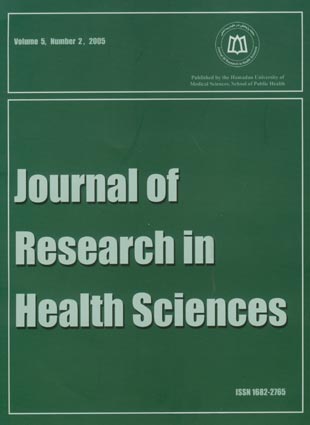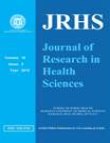فهرست مطالب

Journal of Research in Health Sciences
Volume:5 Issue: 2, Summer-Fall 2005
- 40 صفحه،
- تاریخ انتشار: 1384/10/01
- تعداد عناوین: 9
-
Page 1BackgroundDrug injection is one of the most significant risk factors for viral hepatitis and human immu-nodeficiency virus (HIV) infection. The present study was performed to evaluate the frequency of hepatitis B (HBV) and HIV infection in IDUs and to identify the risk factors of these infections in this group in a central city of Iran, Shahre-Kord.MethodsThis study was conducted in 2004 with a study population of 133 Intravenous drug users (IDUs) in a voluntary drug treatment center. Information on demographics, HBV, and HIV-related risk behaviors were obtained through an interviewer-assisted questionnaire. IDUs serum samples were screened for HBV and HIV infection using Enzyme-linked immunosorbent assay (ELISA). All HIV positive samples were con-firmed by Western blotting.ResultsOf the 133 IDUs, 1 (0.75%) was HIV+ and 8 (6.2%) were Hepatitis B surface antigen positive (HbsAg+). The mean age of HBV infected IDUs was 31.13 years. The prevalence of HBV infection was more than that of the HIV infection. Using Chi-square test it was found that there was significant correlation between using shared syringe and infection with both HIV and HBV (P <0.05).ConclusionThis is the first prevalence study of HBV and HIV infection among IDUs in Shahre-Kord. We concluded that drug users had an elevated prevalence of HBV and HIV infection. Drug injection is the most important risk factor associated with blood-borne viral and particularly HIV and HBV infections.
-
Page 6BackgroundHepatitis B virus is one of the most common causes of chronic liver diseases. Vaccination is the best way of prophylaxis and is of utmost importance. This study was conducted to compare the prophy-lactic effect of intradermal and intramuscular injection of hepatitis B vaccine.MethodsA blind randomized clinical trial was performed among subjects who presented to the infectious diseases clinics to receive HB vaccine in Mashhad, north east Iran, during 2002- 2004. Eighty men and women who were HBs Ag & HBs Ab negative were randomly received 0.1 ml intradermal (study group) or 1ml intramuscular (control group) vaccine. The vaccine was injected into the deltoid region at months 0, 1, and 6. One month later, the HBsAb level was checked. The levels less than 10IU/L, 10-100 IU/L and more than 100 IU/L were defined as negative, mild positive and strong positive responses, respectively.ResultsIntramuscular and Intradermal injections resulted in 95%, 87.5% strong positive, 2.5%, 7.5% mild positive and 2.5%, 5% negative responses respectively. Mann-whitney and Fisher’s Exact Test showed the difference between results was not statistically significant (P>0.05).ConclusionDue to small difference in the effectiveness of these two methods and the cost effectiveness of intradermal injection, this route could be substituted for intramuscular injection.
-
Page 11BackgroundSpina bifida and anencephaly are among serious and fatal anomalies in infants that may lead to a 50-70% of reduction in incidence when folic acid is consumed before conception.MethodsIn a cross sectional study, 2997 pregnant women were evaluated to determine the level of their knowledge and practice about using folic acid in Fars Province, southern Iran.ResultsEighty percent of pregnant women were familiar with the name of folic acid, 44.7% had the knowl-edge of its importance during pregnancy, 31.2% and 8% had the knowledge about its effect in reduction of fatal and neurotic anomalies in fetuses, respectively. 86.6% consumed folic acid and 11% used it before awareness of their pregnancy.ConclusionRegarding the importance of the starting time of folic acid consumption in prevention of neural tube defects, the women should be trained in relation to starting of its consumption before conception.
-
Page 15BackgroundPassive or environmental smoking is one of the important health problems, to which many adults and children are exposed in involuntary status.MethodsIn this hospital based case-control study, household exposure to tobacco smoke as an estimate of passive smokers was conducted in Hamadan, western Iran. The purpose was to find the relationship between environmental smoking and incidence of coronary heart disease (CHD). We interviewed 69 patients with CHD and 69 without it as control group. The confounded factors (hypertension, hypercholestrolemia, diabetic mellitus, type a personality, and familial history) were removed as exclusion criteria while suppliers of oral contraceptives, physical activity, martial status and age (±3) were matched.ResultsThe findings showed that 54% of patients and 48% of the controls were exposed to tobacco smoke. The odds ratio of incidence of CHD was 1.26 and confidence interval (CI) as 0. 65-2. 46.ConclusionThere was no significant relationship between passive smoking and CHD. More study on large sample is needed to assess environmental smoking effect on CHD.
-
Page 20BackgroundHepatitis B is the most common cause of acute viral hepatitis in the world. A small number of epidemiological studies, show the role of sucking insects in the transmission of hepatitis B as mechanical vector. In order to determine the prevalence of HBsAg in patients with malaria and to compare with healthy blood donors, this study was conducted.MethodsIn this case-control study, 150 malarial patients were observed in Zahedan, Southeast Iran in 2000-2001. All patients were selected randomly from 10 health centers in four areas of Zahedan. Control group (150 blood donors), also were selected randomly using random number table. After recording the demo graphic data, 5 ml of blood was drawn from each case and were evaluated by ELISA method (Sorin biomedi cal kit) for HBsAg.ResultsThe prevalence of HBsAg was higher in malarial patients than blood donors and there was a signifi-cant difference in the prevalence of HBsAg between two groups (P= 0.049). In addition, there was a signifi-cant difference between the prevalence of HBsAg and sex
-
Page 23Backgounds: A number of studies have focused on the effects of season of birth, as an environmental fac-tor, on embryonic development.MethodsIn a retrospective descriptive work, heights (crown to heel), weights and head circumferences of the full term, normal, and singleton newborn infants in Hamadan City (west of Iran) were collected from their randomly selected files in Fattemieh Hospital during five consecutive years (1998-2002). The studied files were 1800 cases, about 15% of total live births in the hospital during the considered period. We statistically compared the above parameters in four seasons.ResultsSeasonal variation of mean birth weight and mean birth height were not statistically different. How-ever, mean head circumference showed a peak in winter and a decline in autumn with statistical significant (P<0.005).ConclusionWe can conclude that season of birth can be considered as one of the environmental factors that affect on embryonic development.
-
Page 27Background2, 4-dichlorophenoxy acetic acid (2, 4-D) is well known as inexpensive herbicides but it can give rise to undesirable pollution. The objective of this investigation was to describe a photo-chemical system for degradation of 2, 4-D.MethodsA designed photolytic cell system was used in this study with a 150W or 400W UV lamp. A set of experiments was carried out at pH 1.5, 2.5, 3.5 and 4.5 to investigate the effect of pH on the degradation rate of 2, 4-D. The samples were collected and analyzed by UV spectrophotometer, and HPLC.ResultsWith a 150 WUV- source, the percentage degradation of 2, 4 -D after one hour was 3% while 60% of destruction was achieved using a 400W. The percentage degradation of 2, 4-D was 19% and 99.9% after 8 hours with a 150 W or 400 W UV lamp, respectively. The complete degradation of 2, 4-D was achievable with addition of hydrogen peroxide after 120 and 15 min using 150 W and 400 W UV lamp, respectively.ConclusionThis investigation finding shows that 2, 4-D is degradable in acidic pH of 2.5 or 3.5. In addition, 2, 4-D degradation can be achieved in wastewater by UV light and depends on intensity of lamp or present of H2O2 oxidant.
-
Page 32BackgroundThe main cause of discontinuing the use of depomedroxy progesterone acetate (DMPA) is ir-regular bleeding. This study compared placebo with two kinds of combined oral contraceptive pills including low dose (LDOCP) and high dose (HDOCP) on control of abnormal uterine bleeding in DMPA users.MethodsNinety DMPA users complaining of bleeding were studied in a triple blind randomized clinical trial. Bleeding days were observed for 4 mo. Analysis of results was done by SPSS for Windows.ResultsAge, education, and bleeding days in prior month were similar in all three groups. The bleeding in all three groups were reduced in the first, second, third and fourth months of the study comparing to the month before it. Although time factor was effective in all groups, considering combination of two factors, time and treatment methods including all visits, there was no significant change in duration of the 4 mo. However, significant changes were recorded in the first month in treatment group comparison with placebo.ConclusionTime is the main factor in reduction of irregular bleeding of DMPA users. Two kinds of OCP have important effects in quicker reduction or stoppage of bleeding, although not continuous in the following months.
-
Evaluation of QIAamp DNA mini kit for removing of inhibitors in detection of Cryptosporidium parvum oocysts in water samples by a nested- PCR assayPage 44hjsd gkjs kjsh kj hgjkh gsdjkjksdhkjdg hjksdhkjsdg hjksdh jksd hsdjk hjskdh gsdkjhjksd hsjdkh jksdhg sdjk ghsdjkh gsjkdg jdsk hsjdk hjksd ksjd ghjks dksj djkdsh gkjsdjk sdj ksdgjksd jks djkgj ksdj ksd hjsd hjkjkgds sdk hskjd hgjksdh jksdhkds


